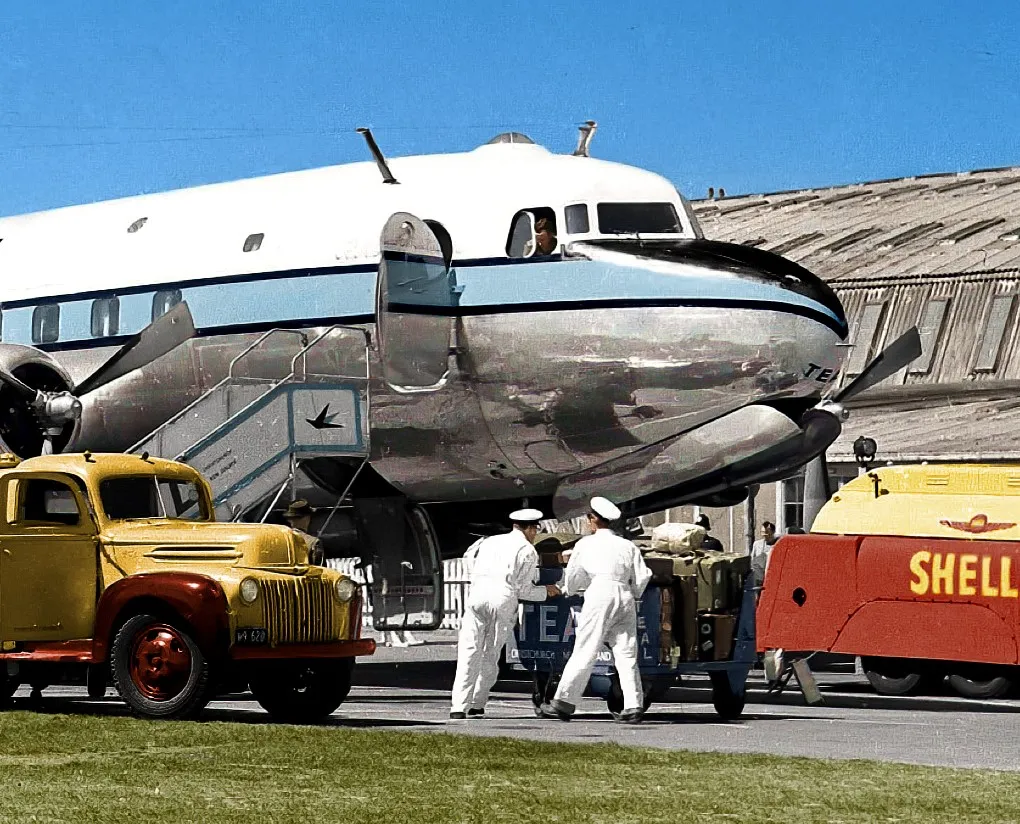
Magnificent colorisation of a TEAL DC-6
Mar 06, 2021

The TEAL DC-6, a classic aircraft from the golden age of aviation, is brought to life through magnificent colorisation that highlights its sleek lines and elegant design. The vibrant hues of teal and deep blue evoke the spirit of mid-20th century travel, while the meticulous attention to detail enhances its retro charm. This restoration not only showcases the beauty of the aircraft but also pays homage to its significant role in connecting distant lands. The colorisation captures the essence of adventure and nostalgia, inviting viewers to imagine the journeys taken aboard this iconic plane.
Understanding the Magnificent Colorisation of the TEAL DC-6
The TEAL DC-6 is not just a marvel of aviation history; it also presents a unique opportunity for exquisite colorisation. This aircraft, which has captured the hearts of aviation enthusiasts and historians alike, has become a canvas for artistic expression. The process of colorisation involves adding vibrant hues to black-and-white images, allowing us to visualize these remarkable machines in a new light. The TEAL DC-6, with its sleek design and historical significance, serves as an excellent subject for such artistic endeavors.
The Historical Significance of the TEAL DC-6
The TEAL (Tasman Empire Airways Limited) DC-6 was instrumental in connecting New Zealand with the rest of the world during the mid-20th century. This aircraft was pivotal in establishing trans-Pacific air travel, making it a beloved icon in aviation history. The DC-6's ability to fly long distances, combined with its reliability, made it a popular choice for airlines during its era. By colorising images of this aircraft, we not only preserve its legacy but also bring forth an appreciation for its design and function.
Colorisation Techniques
Colorisation of historical photographs involves several techniques that breathe life into monochrome images. Here are some key methods used in the colorisation process:
| Technique | Description |
|---|---|
| Manual Colorisation | Artists use digital tools to paint over black-and-white images, adding colors based on historical accuracy and artistic interpretation. |
| AI Colorisation | Artificial intelligence algorithms analyze photographs to predict and apply colors, often resulting in quick yet impressive results. |
| Hybrid Method | A combination of manual and AI techniques, allowing for detailed accuracy while speeding up the process. |
The Impact of Colorisation on Aviation Enthusiasts
For aviation enthusiasts, the colorisation of historical aircraft like the TEAL DC-6 has a profound impact. It enables a deeper connection to the past, allowing individuals to visualize what these aircraft looked like during their operational days. The vibrant colors can evoke nostalgia, making the aircraft feel more relatable and less like a relic trapped in time.
Moreover, colorised images can serve as educational tools, helping younger generations to appreciate aviation history. Schools and museums can utilize these images in exhibits, bringing history to life in a way that black-and-white photographs simply cannot.
Challenges in Colorisation
While colorisation is an exciting process, it is not without its challenges. Here are some hurdles faced by artists and historians alike:
- Historical Accuracy: Ensuring that colors are accurate to the time period can be difficult, especially when original data is scarce.
- Artistic Interpretation: Different artists may have varying interpretations of how to colorize an image, leading to discrepancies.
- Technological Limitations: While AI has advanced significantly, it still faces challenges in correctly identifying colors and textures.
The Future of Colorisation in Aviation
As technology continues to evolve, the future of colorisation looks promising. With advancements in AI and digital art tools, we can expect even more lifelike images of historical aircraft. This growth is beneficial not only for aviation enthusiasts but also for historians and educators who seek to make history accessible and engaging.
Furthermore, as more people become interested in aviation history, we may see an increase in projects aimed at colorising other significant aircraft. This not only preserves the past but also encourages a greater appreciation for the art of aviation.
Conclusion
The magnificent colorisation of the TEAL DC-6 represents much more than just an artistic endeavor; it is a bridge connecting the past with the present. As we continue to explore the rich history of aviation through colorised images, we will undoubtedly find new ways to engage with and celebrate these incredible machines. With resources like referrerAdCreative, enthusiasts can share their passion and knowledge, fostering a community that values both history and artistry.
In summary, the colorisation process plays a crucial role in preserving the legacy of the TEAL DC-6 and similar aircraft, making them accessible and relatable to future generations. Through innovative techniques and a shared love for aviation, we can ensure that the stories of these magnificent machines continue to inspire and educate.
Related Articles

Explore Thailand: The Best Islands to Visit for Paradise, Adventure, and Relaxation

The Ultimate Guide to the Best Islands in Thailand for Your Next Getaway

Do babies need passports? How to get a passport for a newborn

How to get a U.S. passport fast: here’s how to expedite the process

What is Mobile Passport Control: 5 reasons why you should use it

SENTRI vs. Global Entry: A detailed guide

Do you need a passport to go to the Bahamas? Let’s find out

Do you need a passport to go to Mexico? A detailed guide

Do you need a passport to go to Canada? We got the answer

Do You Need a Passport for a Cruise: An Essential Travel Guide

Booster Seat Requirements: All the Rules to Follow in Your Rental Car

What Are the World’s Most Powerful Passports, and How Does Yours Rank?

How to Take a Passport Photo at Home: A Helpful Guide

You've got to have heart! Southwest's new livery

Your opinion: Should water be free on low cost carriers?

Young women bolder than guys as solo travellers
